#insect biodiversity
Explore tagged Tumblr posts
Text

Study after study show that planting native plants- especially in areas like cities where food is more scarce- makes a *huge* difference for your neighborhood’s insects.
You don’t need to know a ton about plants or be a master gardener here to make a difference. You don’t even need a yard! Have a patch of concrete? Get the biggest pot you can fit there and plant some native plants in there.
For Philly, I’ve had good luck with bee balm, swamp milkweed, and purple coneflower. The milkweed (shown in the drawing above) is a major hit for the bees on my sidewalk. Once you get it going it’s hardy, and gets lots of different insects visiting. Bonus? It’s the *only* plant monarch butterflies can lay eggs on.
If you’re hardcore you can grow plants from seeds, but if you wanna do this on easy mode, find a nursery near you that sells native plants. In Philly there are a few great options, including Good Host Plants and Redbud Nursery.
If you’re not in Philly, you’ll have to do a little research on what works best near you. Prairie Moon can source many different species!
If you have access to public areas, check out The Xerces Society They have lots of resources and even a grant program to supply you with plants. They’re a phenomenal resource.
One last thing- a lot of seeds for native plants need to get super cold before they’ll actually grow, so starting to think about this stuff in December is important if you want to grow from seed. 🌱
#Biodiversity#Little actions add up#Insect biodiversity#insects#invertebrates#urban biodiversity#help a bug#bee#bumblebee
141 notes
·
View notes
Text
Hello everyone,
A bit of a garden, chicken and otherwise update:)
First up! Garden stuff update :).

Our first cucumber! This pic is a few days old, so it's just about ready to pick now and I've spotted 2 more coming in too :)

First patty pan squash :D with luck this years the year we are able to actually eat a few squash from the plants before the squash beatles arrive! :D

Sweet potato starts in the ground. I may need to put a bit of a shade cover and will be planting at least one more tuber to kick start the greens.

These very pretty wasps (who I believe is a yellow paper wasp if internet search has led me well.) Arrived. Very beautiful, but unfortunatly like the yellow bellied assassin's I will need to keep an eye out for them and potential nesting habits. For the safety and comfort of human neighbours and self, rather than protecting the rare native Bees we see. Thankfully It looks like this one was just hanging out for a few minutes.
Three more assassin's were spotted and swatted over the last few days. Morning has been the best time to look for them so far as I can see or tell.

My funny shade/seed/chicken bed. It looks a bit rough but the goal for this area is mostly to fill the empty space with something that is
1) edible to us or the chickens.
2) managing some sort of eco aspect of our space (shade, water retention, soil cover, beautification)
3) medicinal in some way ( soapmaking or makeup)
4) is fairly leave it alone/set it and forget it.
I'll need to reseed some new stuff soon though as the kale and chard are just about done I think.

Some of the tossed out sunflowers by the watermelon patch.
The melon patch I started (that the chcikens dug up entirely 😭 ) is being fully dug out right now to make a better grow space long term. Given that it's hot out (already 100*f regulalry) and daily life business, I've been working on it as the sun's been going down. It's taking a bit, but a bit at a time makes the work pass by. The dirt being dug out is being used to fill in chicken potholes for the yard and coop. When it's fully dug out I'll be making a similar growbed box like I did for the sweet potatos. Most likely also with a short shade cover.

And last, a chick pic update :) these ones have been much hardier than the last batch so far and a lot less skittish. They got their first hand feeding of crickets and mealworms, plus some peices of apple.
That's it for today
🌱🌻Happy Homesteading and Gardening 🌻🌱
#homesteading#thestudentfarmer#self sufficient living#studentfarmer#self sufficiency#food#garden#gardening#low waste#chickens#chick pic update#garden update#urban green spaces#urban biodiversity#urban homesteading#urban gardening#urban farming#insects#insect biodiversity#use it wisely#smalls scale differences#living with nature#garden pests#seed collector#backyard flock#backyard solutions#food desert#local food system#grow what you eat#feed yourself
7 notes
·
View notes
Text

Giant Malaysian leaf insect
Carpenter ant?
Royal Goliath beetle
Blue Dasher
Polyphemus moth
Goliath stick insect
Two-spot lady bird
Harlequin ladybird
Rhetenor blue morph butterfly
Monarch butterfly chrysalis
Colorado potato beetle?
Luna moth caterpillar?
Some kind of katydid?
#charley harper#insect world#insect biodiversity#animal identification#idk folks it's hard to ID a brown ant#insects: not my strong suit
7 notes
·
View notes
Text
"In 2021, scientists in Guelph, Ontario set out to accomplish something that had never been done before: open a lab specifically designed for raising bumble bees in captivity.
Now, three years later, the scientists at the Bumble Bee Conservation Lab are celebrating a huge milestone. Over the course of 2024, they successfully pulled off what was once deemed impossible and raised a generation of yellow-banded bumble bees.
The Bumble Bee Conservation Lab, which operates under the nonprofit Wildlife Preservation Canada, is the culmination of a decade-long mission to save the bee species, which is listed as endangered under the Xerces Society for Invertebrate Conservation...
Although the efforts have been in motion for over a decade, the lab itself is a recent development that has rapidly accelerated conservation efforts.
For bee scientists, the urgency was necessary.
“We could see the major declines happening rapidly in Canada’s native bumble bees and knew we had to act, not just talk about the problem, but do something practical and immediate,” Woolaver said.
Yellow-banded bumble bees, which live in southern Canada and across a huge swatch of the United States, were once a common species.

However, like many other bee species, their populations declined sharply in the mid-1990s from a litany of threats, including pathogens, pesticides, and dramatic habitat loss.
Since the turn of the century, scientists have plunged in to give bees a helping hand. But it was only in the last decade that Woolaver and his team “identified a major gap” in bumble bee conservation and set out to solve it.
“No one knew how to breed threatened species in captivity,” he explained. “This is critically important if assurance populations are needed to keep a species from going extinct and to assist with future reintroductions.”
To start their experiment, scientists hand-selected wild queen bees throughout Ontario and brought them to the temperature-controlled lab, where they were “treated like queens” and fed tiny balls of nectar and pollen.
Then, with the help of Ontario’s African Lion Safari theme park, the queens were brought out to small, outdoor enclosures and paired with other bees with the hope that mating would occur.
For some pairs, they had to play around with different environments to “set the mood,” swapping out spacious flight cages for cozier colony boxes.
And it worked.
“The two biggest success stories of 2024 were that we successfully bred our focal species, yellow-banded bumble bees, through their entire lifecycle for the first time,” Woolaver said.
“[And] the first successful overwintering of yellow-banded bumble bees last winter allowed us to establish our first lab generation, doubling our mating successes and significantly increasing the number of young queens for overwintering to wake early spring and start their own colonies for future generations and future reintroductions.”
Although the first-of-its-kind experiment required careful planning, consideration, resources, and a decade of research, Woolaver hopes that their efforts inspire others to help bees in backyards across North America.
“Be aware that our native bumble bees really are in serious decline,” Woolaver noted, “so when cottagers see bumble bees pollinating plants in their gardens, they really are seeing something special.”"
-via GoodGoodGood, December 9, 2024
#bees#insect#save the bees#xerces society#biodiversity#conservation#endangered species#wildlife conservation#canada#north america#climate action#climate news#good news#hope
6K notes
·
View notes
Text
Blister Beetles: Pretty colors, serious powers
🌿🐞 Did you know about Nuttall’s Blister Beetles? These vibrant insects are a part of our local parks and greenspaces, often found on flowers like lupines and milk-vetch. 🌼 While they may look beautiful with their bright colors, handling them can be risky! 🚫 Their bodies contain cantharidin, a toxin that causes skin blistering if mishandled. Here’s how to enjoy nature safely: 👀 Spot them…

View On WordPress
#beetle biology#beetle diversity#beetle larvae#beetle life cycle#blister beetle#cantharidin#ecosystem balance#entomological study#entomology#environmental impact#flower feeders#flower pests#garden management#garden pests#garden safety#George Genereux Urban REgional Park#greenspace insects#insect anatomy#insect behavior#insect biodiversity#insect defense#insect ecology#insect habitats#insect identification#insect protection#insect toxin#insect venom#Lytta#natural habitats#North American insects
0 notes
Text
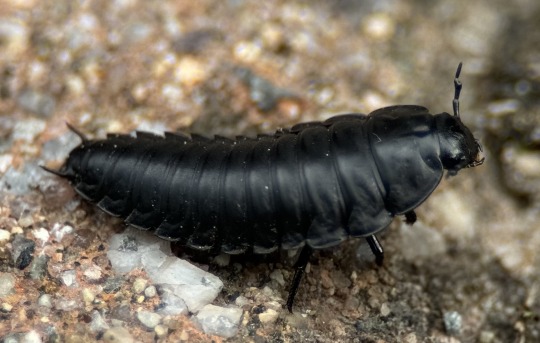
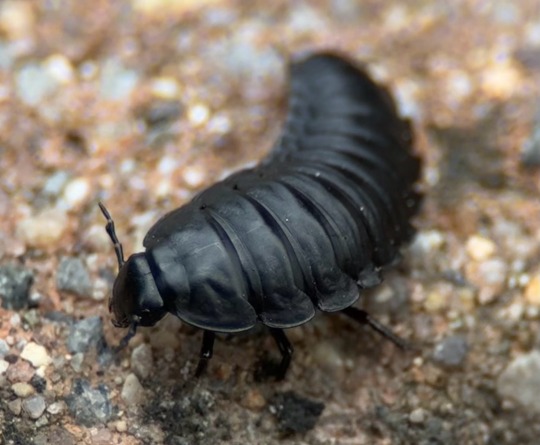
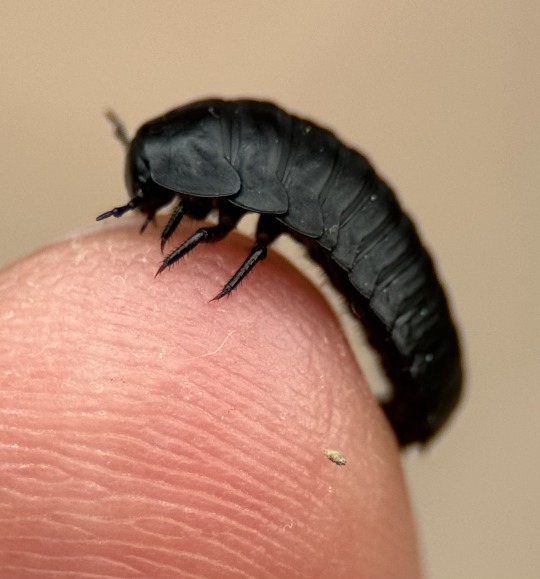
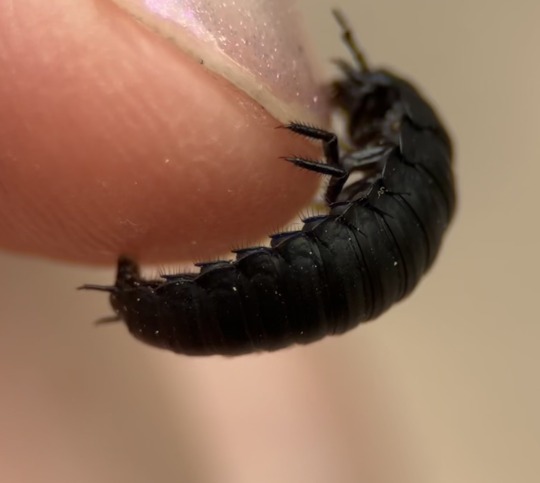
I thought this feisty little critter was an isopod until I got a closer look. This is a carrion beetle larva, and, as their name suggests, adults and larvae of this insect eat dead animals, maggots that live in carrion, and/or other types of decaying organic matter. I have no idea where this one came from, since there were no dead animals nearby or compost. Perhaps an insectivorous bird dropped it, or maybe this particular species likes chicken manure (there was a chicken tractor nearby vroom vroom). Putting this next part below the cut because it's a little gross. Proceed with caution:
This carrion beetle child seemed somewhat hungry, as it was nibbling at some dead skin around my finger nail. It tickled a bit and reminded me of the shrimp they sometimes have at aquariums that will nibble at your fingers. Yes that's a thing.
unidentified Silphidae larva Northeastern Pennsylvania, US
#carrion beetle#Silphidae#beetle#coleoptera#carrion beetle larva#larva#insect#nature#bugs#nature photography#biodiversity#animals#bugblr#inaturalist#arthropods#entomology#insect appreciation#child#chicken tractor#vroom vroom#not an isopod#nature's best manicure#nom nom#creature#macro#macro photography
2K notes
·
View notes
Text
Insects are critical to the survival of most other animals, including humans. But many insect species, from beetles to dragonflies to butterflies, are declining in abundance due in part to human activity. For Earth Month, Insectarium host Dr. Jessica L Ware gives tips on small things each of us can do to make a lasting impact and help insects thrive for years to come.
Learn more about insects with Museum Curator Jessica Ware in Insectarium on PBS Terra's YouTube channel.
#science#amnh#museum#natural history#nature#animals#insects#bugs#entomology#conservation#biodiversity#earth day#earth month
722 notes
·
View notes
Text
Have a little good news to start the week. One little butterfly may not seem like a big deal, but every species we manage to save means better biodiversity and a healthier ecosystem overall. Moreover, there is something profound in knowing that you've helped to protect a unique evolutionary lineage that has fluttered on for thousands of years, and which once lost would be gone forever.
I know the world can feel overwhelming at times, with extinctions happening at a much higher rate than normal, ecosystems worldwide in peril, and headlines focusing primarily on the negative. But remember that there are also so, so many people working every day--right now, in fact--to protect these most precious, wonderful beings and their homes that we share this planet with. The above story is just one of thousands, most of which never hit the news cycle, but which are still having a positive impact quietly, behind the scenes.
I think it's an important thing to remember in these days. I know this particular Gandalf quote only came from the Hobbit movies, not the book, but I still think it's appropriate here: "It is the small everyday deeds of ordinary folk that keep the darkness at bay. Small acts of kindness and love." And what else motivates someone to save a tiny butterfly, but an intense love for the natural world?
#nature#wildlife#animals#biodiversity#wildlife conservation#conservation#environment#endangered species#extinction#hope#good news#hopepunk#ecology#habitat restoration#butterflies#insects#invertebrates#scicomm#entomology#pollinators
176 notes
·
View notes
Text
I see at least one cool bug a day, and usually many more, but it’s not because I live anywhere particularly rich in strange, wonderful creatures (I live in an unremarkable corner of Pennsylvania, USA) or spend all of my free time looking for bugs (well, just *most* of it). in my experience, finding interesting bugs is less about actually locating them and more about looking closely at tiny things you’d otherwise ignore!
this very long post was compiled over a couple days in late July, although I spent less than 10 minutes at a time searching. there’s a lot of fun creatures just out in the open.

plants are always a good place to start when looking for bugs, and I chose this small fig tree (Ficus carica) with a mulberry sapling friend. feeding on the sap of the fig and mulberry is the first group I’ll take a look at, the planthoppers:

these two are flatid bugs, Metcalfa pruinosa and Flatormenis proxima. flatids are slow-moving bugs that can be approached closely, but once they get tired of circling around stems to avoid you they may launch themselves into a fluttering flight with spring-loaded rear legs.
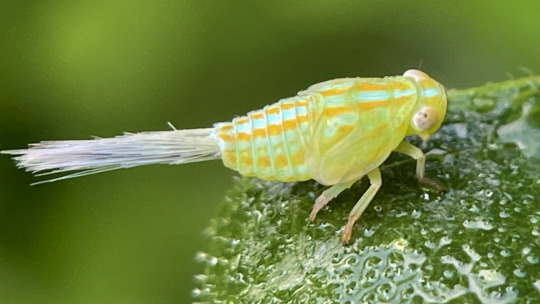
Aplos simplex, a member of the related family Issidae, also likes fig sap. its “tail” is actually a tuft of waxy secretions, which get shed along with the bright colors when it assumes a lumpy, bean-shaped adult form.
cicadellids, or leafhoppers, are just about everywhere on plants, but can be hard to approach without scaring them.
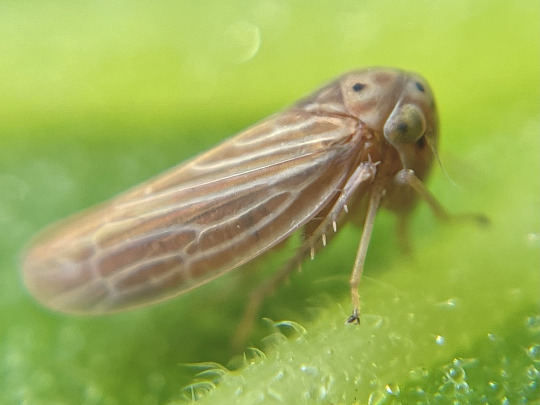

Agallia constricta on the left is a tiny species that feeds on grass, but many were scared up onto the fig by my footsteps. Jikradia olitoria is a much larger species that does feed on the fig; juveniles like this are curled, creeping goblins while adults’ rounded wings give them a pill-shaped appearance.
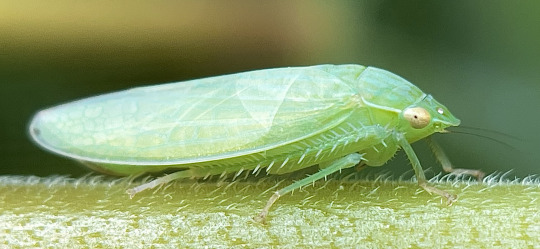
this big, pale leafhopper belongs to genus Gyponana. it’s tricky to get to species ID with these.
Graphocephala are striking little hoppers that eat a variety of native and nonnative plants. G. coccinea is the larger, more boldly colored one and G. versuta is smaller but more common locally. they’ll sit on the tops of leaves but take flight if you get too close quickly.


another group you’re almost guaranteed to encounter are flies (Diptera). these are a very diverse group, so much more than houseflies and mosquitoes (though I did run into both)
where I live, any plant with broad leaves is almost guaranteed to have a few Condylostylus, long-legged flies that come in shades of blue, green, and red. despite their dainty physique, they’re agile predators, typically feeding on other small flies.
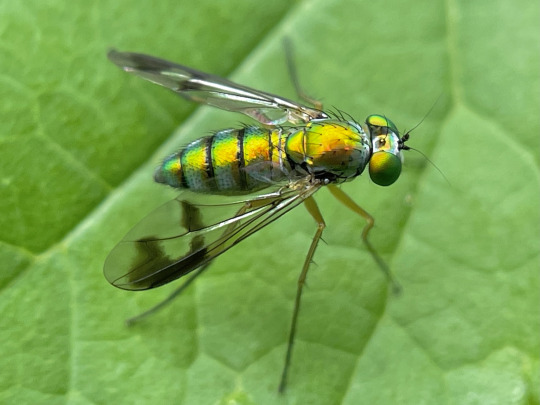
next, a few hoverflies: the ubiquitous Toxomerus geminatus and a Eumerus that I’ve been seeing a lot of this year (but maybe I’ve just noticed them for the first time). syrphids have varied life histories, but most adults drink nectar and many of the larvae are predaceous on aphids.
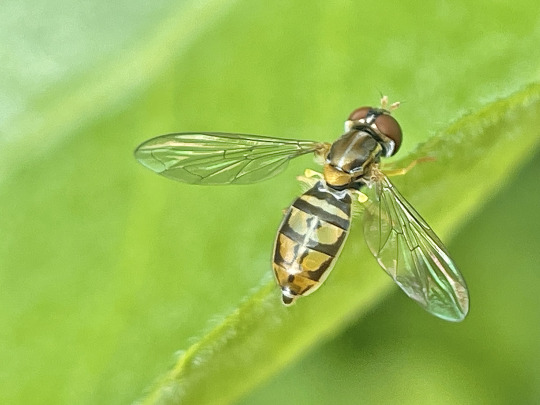

the metallic green soldier fly is Microchrysa flaviventris, nonnative here. Coenosia is a fun example of a “fly that looks like a fly,” with big red eyes and a gray body, and you might think they’re just another dung-sucking pest, but they’re actually aggressive predators! this one seemed to have nabbed itself some sort of nematoceran fly, maybe a fungus gnat.
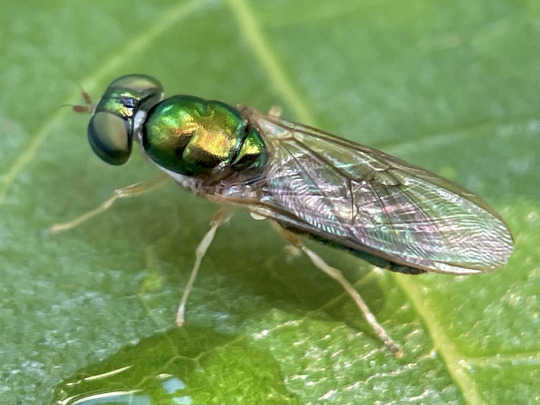

many flies are very tiny, just millimeters long. the first two little fellows are lauxaniids, while the last one, an agromyzid leafminer Cerodontha dorsalis, burrows through grass leaves as a larva.
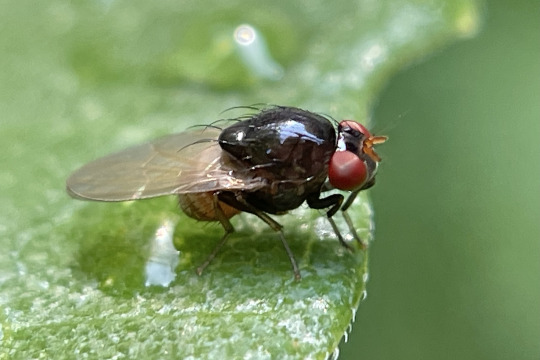
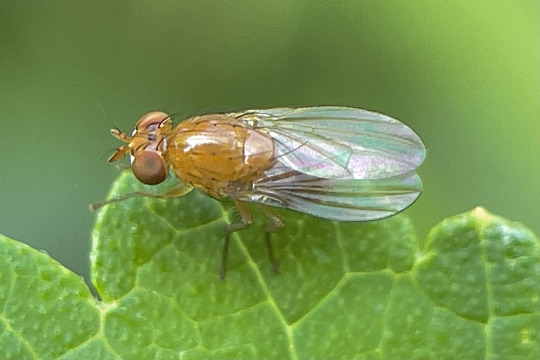

while moths and butterflies (Lepidoptera) are drawn to plants for their flowers or to lay eggs, many small moths can easily be found resting on or under leaves during the day.
these first two are tortricids, many of which are flat, rectangular moths resembling chips of bark or dead leaves. the apple bud moth, Platynota idaeusalis, feeds on a wide variety of hosts, while this beat-up old Argyrotaenia pinatubana would have developed in an edible tube nest of pine needles.


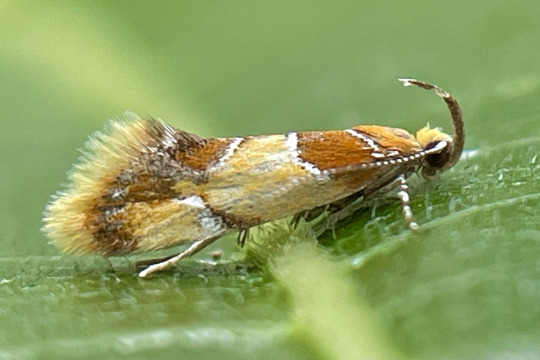
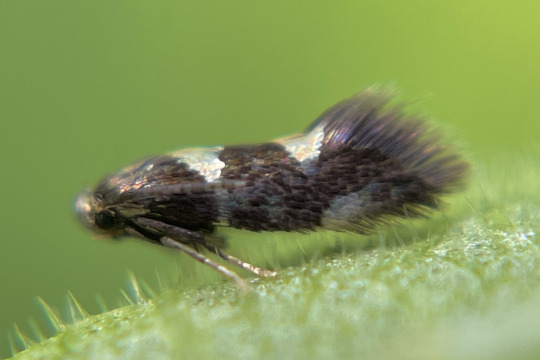
Callima argenticinctella feeds in bark and dead wood (a resource used by more caterpillars than you’d realize!) while the last moth, possibly an Aspilanta, is a leafminer.
although beetles (Coleoptera) are famous for their diversity, I didn’t find too many on the fig. the invasive Oriental beetle Exomala orientalis resting here can be found in a wide range of colors, from this common tan to to deep iridescent black. the other beetle is a Photinus pyralis firefly, sleeping under leaves as fireflies do.
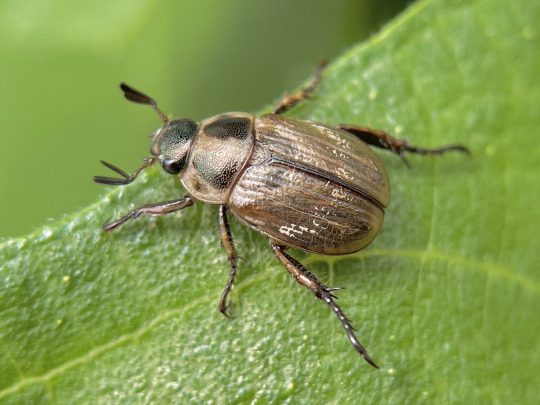
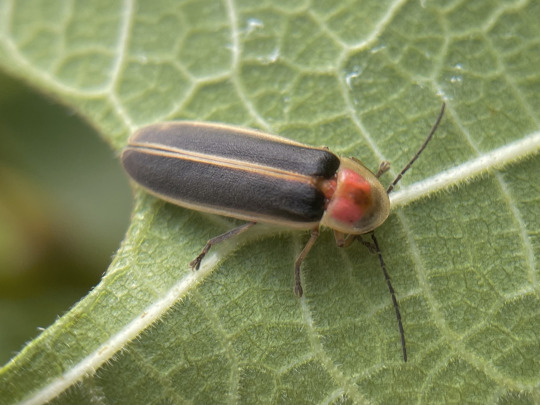
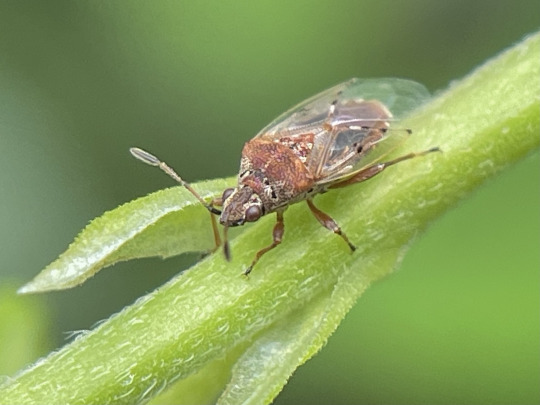
a few spare hemipterans: a Kleidocerys resedae that blew in on a wind, and below, the mulberry whitefly Tetraleurodes mori feeds on its namesake host. as for Hymenoptera, I saw manny tiny parasitic braconid wasps and various ants attracted to the planthoppers’ honeydew excretions—always worth checking underneath roosting hoppers for things having a drink.

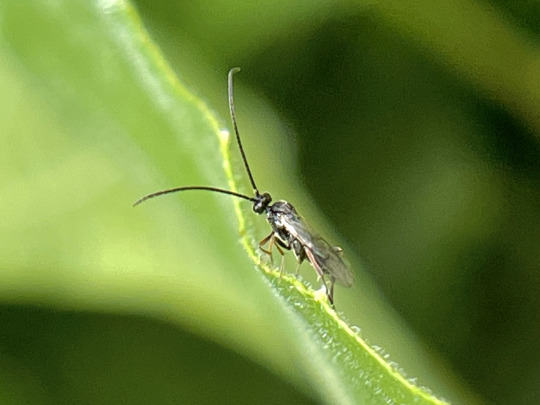
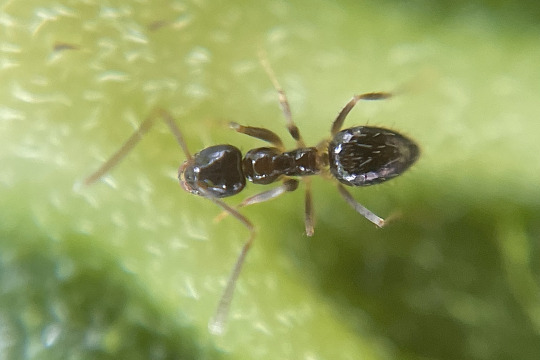
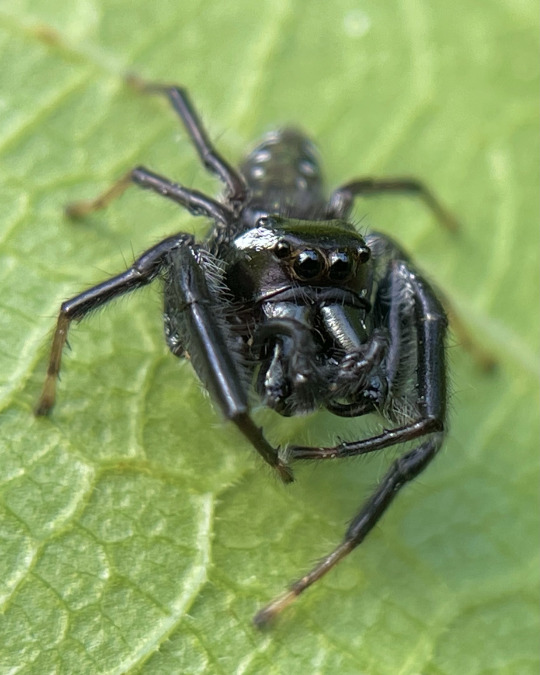
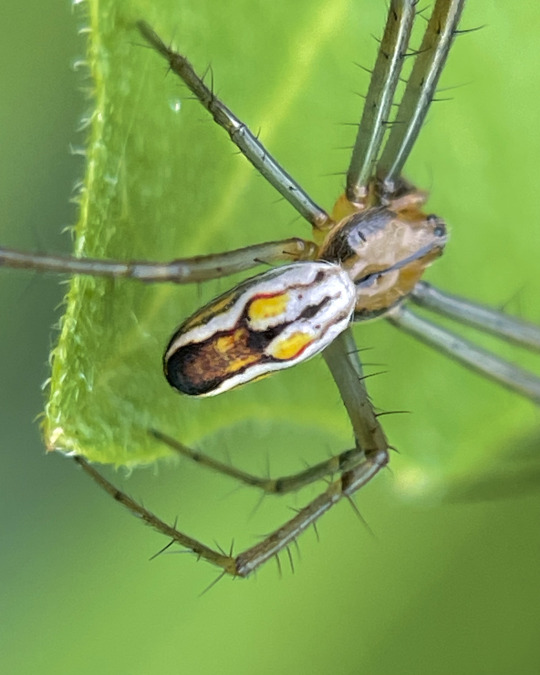
a couple handsome spider boys were scrambling through the fig seeking females, a jumping spider Paraphidippus aurantius and an orbweaver, Mecynogea lemniscata.
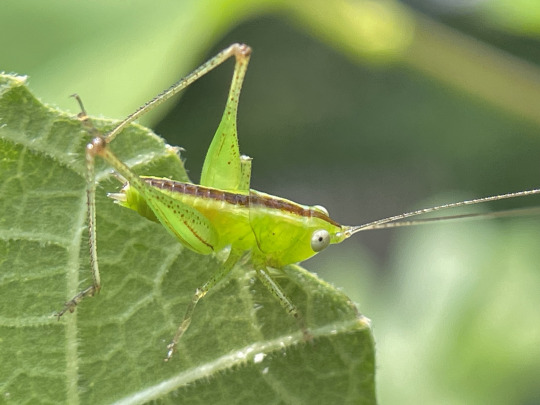
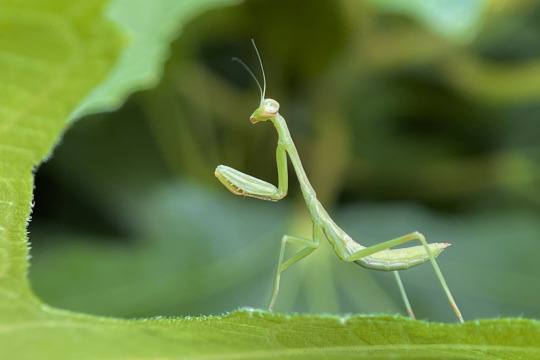
and to round it off, a young Conocephalus meadow katydid and a Carolina mantis, Stagmomantis carolina.
there’s 31 species of arthropod in this post, and I probably saw some 45, not all of which stayed for photos. if you walk slowly and look closely, you can see a sizeable chunk of your local biodiversity in under fifteen minutes! of course this will depend on where you live and what time of year it is, but there’s almost always more cool bugs out there than you’d expect, even on just a single plant.
1K notes
·
View notes
Text

Tiny perfect treehoppers. These studies were drawn from specimens in a beautiful piece by Fukui Keiki in Tokyo.
#treehopper#insect#insect art#animal art#artists on tumblr#sketches#art#drawing#traditional art#pen#ink#bug#entomology#biodiversity
459 notes
·
View notes
Text
How Non-Native Plants Are Contributing to a Global Insect Decline
The impact of introduced plants on native biodiversity has emerged as a hot-button issue in ecology. But recent research provides new evidence that the displacement of native plant communities is a key cause of a collapse in insect populations and is affecting birds as well...
#non-native plants#invasive species#environment#conservation#insect decline#insect#insects#entomology#biodiversity#animals#nature#botany#plants#non-native invasive species
1K notes
·
View notes
Text
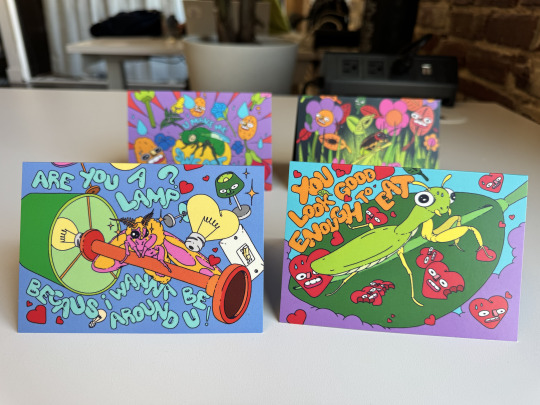
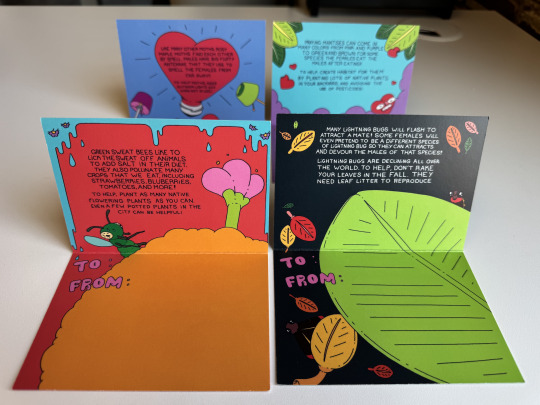
Inject a little science into your Valentines Day with LOVE BUGS valentines!
GET 'EM HERE!
I really love putting science into things people are already doing. Each of these cards has a fact about the animal AND something you can do to HELP the animal. Let's care for our native insects! We love biodiversity!
(I also love getting snail mail. It's just a delight.)
Send these with your kid to school for valentines day exchanges, send them to your friends, bring them to work to bring a little joy (and science!) to the office.
They were designed by Michele Scott in Philly, and printed & packed here at Skype a Scientist HQ (also in Philly).
All sales support science education nonprofit Skype a Scientist!
Tell your friends. Get some Love bugs.
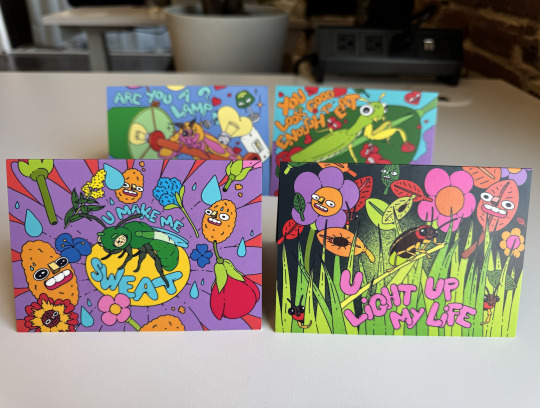
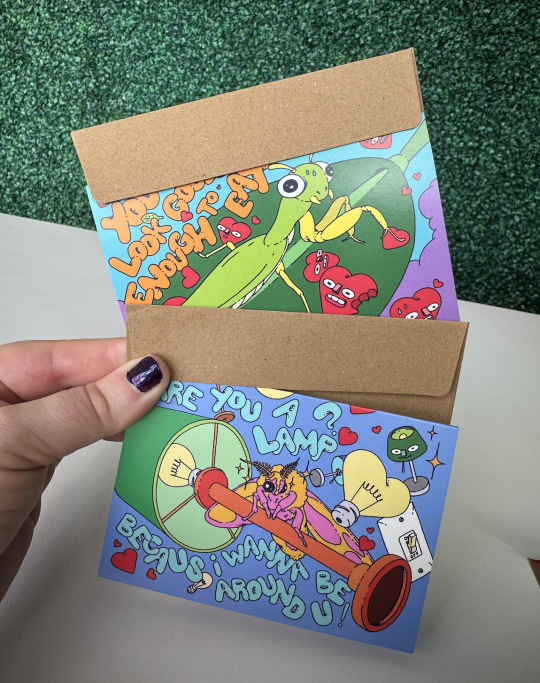
#squid facts#Science#Skype a Scientist#Love bugs#valentines#valentines day#insects#biodiversity#bugs#mantis#rosy maple moth#lightning bug#firefly#Sweat bee#native bugs
2K notes
·
View notes
Text

Isopods, aka roly-polies or pill bugs, - tiny crustaceans with BIG impacts
They’re detritivores, meaning they feast on dead and decaying organic matter—like fallen leaves, wood, and even fungi. 🍂🥀🪵
Here’s why they’re vital for our soil:
🌱 Nutrient Recycling: As they munch through plant material, they break it down into smaller particles, speeding up the decomposition process. This enriches the soil with vital nutrients that plants need to thrive.
🔄 Carbon Cycling: By decomposing organic material, isopods play a key role in the carbon cycle, helping store carbon in the soil and reducing carbon loss to the atmosphere.
🌍 Soil Aeration: While burrowing and feeding, isopods loosen compacted soil, improving oxygen flow and creating a healthier environment for plant roots and microorganisms.
Found on every continent except Antarctica, isopods thrive in forests, gardens, and even urban environments. 🌟 Wherever there’s organic matter to break down, these hardworking decomposers are on the job!
So next time you see an isopod, give it some love! 🤍 They’re working hard to keep our soil alive and thriving. 🌿
#soil health#soil science#soil#permaculture#isopods#pill bug#roly poly#environmental education#environmental awareness#regenerative farming#regenerative agriculture#agriculture#sustainable living#sustainable farming#sustainability#organic life#organic matter#organic lifestyle#organic farming#organic#vermicompost#composting#compost lifestyle#compost#biodiversity#conservation#ecomindset#bugs#insects#nature lovers
78 notes
·
View notes
Text
Insects and spiders are important elements in the food webs of aquatic and terrestrial ecosystems. With declines in their biodiversity, the food supply for birds, fish, reptiles, amphibians and small mammals is not only becoming scarcer, but also poorer in important fatty acids, as an international research team led by scientists from Eawag and WSL has recently demonstrated. Animals not only need sufficient calories to function, but also essential nutrients—including omega-3 and omega-6 polyunsaturated fatty acids (PUFA). Insects and arachnids are an important source of these essential fatty acids for birds, hedgehogs, lizards and the like. However, the content depends on the specific types of insects and spiders consumed.
Continue Reading.
119 notes
·
View notes
Text
"Next Monday [6/17/24] is the start of National Pollinator Awareness Week, and one Colorado advocacy group is hosting a flower planting drive to rewild Colorado’s meadows, gardens, and just maybe, its children too.
Created by constitutional amendment in 1992, Great Outdoors Colorado (GOCO) is a state-funded independent board that invests a portion of Colorado Lottery proceeds to help preserve and enhance the state’s parks, trails, wildlife, rivers, and open spaces.
This year, GOCO’s offshoot Generation Wild is distributing over 100,000 free packets of wildflower seeds to collection points at museums, Denver Parks and Rec. offices, and libraries all over the state to encourage kids and families to plant the seeds in their backyards.
The Save the Bees! initiative aims to make the state more beautiful, more ecologically diverse, and more friendly to pollinators.
According to a new report from the Colorado Department of Natural Resources, 20% of Colorado’s bumblebees are now at risk of extinction. Even in a small area like a backyard, planting wildflowers can make a positive impact on the local ecosystem and provide native bees with a healthy place to live.
“The Western Bumblebee population has declined in Colorado by 72%, and we’re calling on kids across Colorado to ‘bee’ the change,” said GOCO Executive Director Jackie Miller.
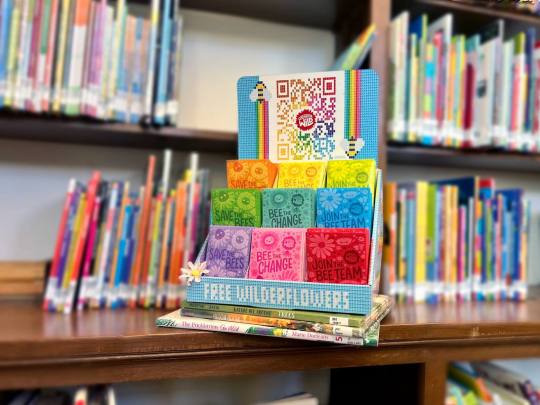
Named after Generation Wild’s official mascot “Wilder,” the Wilderflower Seed Mix was developed in partnership with Applewood Seed Co. and packets are now available for pickup at designated partner sites including more than 80 Little Free Library boxes.
By distributing 100,000 Wilderflower packets, Generation Wild is providing more than 56 million seeds for planting in every nook and cranny of the state. All seeds are regionally-native to Colorado, which is important for sustaining the living landscape of bees, birds, and other animals.
Additionally, by using flower species adapted to the Mile High climate, landscapers and gardeners need to use less water than if they were tending non-native plants.
“Applewood Seed Co. was excited to jump in and help Generation Wild identify a seed mix that is native to the Colorado region and the American West, containing a diversity of flower species to attract and support Colorado’s pollinator populations,” stated Norm Poppe, CEO of Applewood Seed Co. “We hope efforts like this continue to educate the public on pollinator conservation and the need to protect our native bees and butterflies.”
Concluding her statement Miller firmly stated that children grow up better outside, and if you or a parent you know agree with her, all the information on how to participate in Save the Bees! can be found here on their website, including a map showing all the local pickup points for the Wilderflower Seed Packets."
-via Good News Network, June 13, 2024
#wildflowers#wild flowers#colorado#bees#native bees#entomology#insects#save the bees#pollinators#bumblebees#bumble bee#i love bees#biodiversity#native plants#urban gardening#gardening#ecology#conservation#endangered species#wildlife conservation#enviromentalism#good news#hope#hope posting#solarpunk#denver#boulder colorado#colorado springs#libraries#public libraries
484 notes
·
View notes
Text
Bunga widuri, Calotropis gigantea on the side of a road.
I took some seeds, hoping they'll grow in my neighborhood. There were lots of Carpenter bees and I think those are red fire bug nymphs?
71 notes
·
View notes